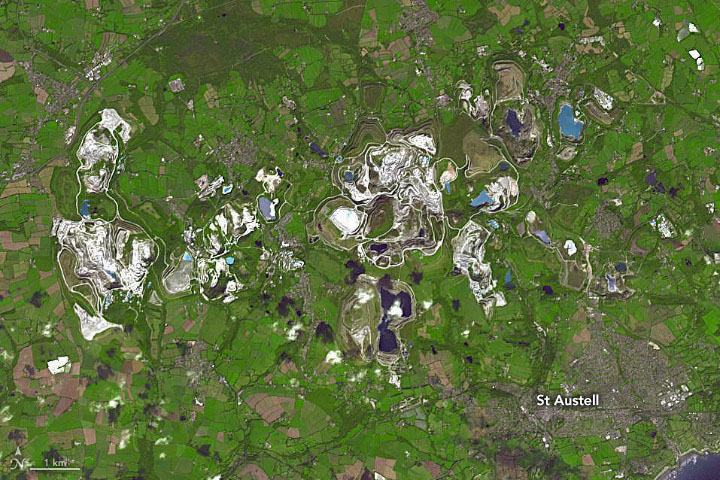Cornwall Clay Mines
Jan 3, 2022
The English porcelain industry began with the 1745 discovery of kaolinite, or “china clay,” at Tregonning Hill, Cornwall. By the early 19th century, the Cornish deposits were the largest known to the world. By 1910, Cornwall was producing 50 percent of the world’s china clay. The mines produced a million metric tons of clay each year, exporting 75 percent of it. Domestically, the clay was used to produce Wedgwood, Spode, and Minton china.
Prior to the discovery of a U.K. source for the clay, the earthenware and stoneware made by the British pottery industry was prone to cracking, often when exposed to temperature changes. The addition of kaolinite produced porcelain that was both more delicate and more durable. Today, some of the U.K. deposits are still being mined, but many others have been abandoned in favor of other sources of clay, mainly from Brazil.
The image above shows the clay pits northwest of St Austell. It was acquired by the Advanced Spaceborne Thermal Emission and Reflection Radiometer (ASTER) aboard the Terra satellite on September 10, 2014. Note that the image is synthetic natural color, combining several different spectral ranges to simulate the look of natural color. Some colors may appear slightly brighter than they would in an aerial photograph.
Clay mining left significant marks on the English landscape. Rain has since collected in many of the abandoned pits, forming ponds of various shades of blue (dependent on the amount of suspended clay minerals). Also, each ton of clay extracted from the ground resulted in multiple tons of waste products, which were piled in spoil tips. These pyramid-shaped mounds still dot the skyline and are sometimes called the Cornish Alps.
Cornwall’s clay deposits owe their existence to the weathering and alteration of granites that are rich in feldspar and mica and low in iron minerals, giving the clay a white color desirable for porcelain. The granites formed when magma intruded into the crust about 280 million years ago during the assembly of the supercontinent Pangea. This process also produced the ores of tin, copper, lead, zinc, and tungsten that have made Cornwall a mining center for centuries.
Much of the geology of southwestern England was deciphered in the late 1800s and early 1900s by William A.E. Ussher, a descendant of the Irish Archbishop James Ussher. The earlier Ussher is known for his dubious 1650 declaration, based on a biblical chronology, that Earth was roughly 6,000 years old, having been created on the morning of October 23, 4004 B.C.E.
The Ussher Society, founded in 1962 to promote the study of geology and geomorphology in southwest England, was named after William Ussher to honor his contributions in establishing the stratigraphical succession of the rocks in Devon and Cornwall. He found that much of the rock was formed during the Devonian, Carboniferous, Permian, and Triassic periods between 420 million and 200 million years ago.
Image courtesy of NASA/METI/AIST/Japan Space Systems, and the U.S./Japan ASTER Science Team. Story by Sara E. Pratt.
